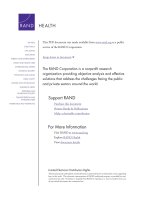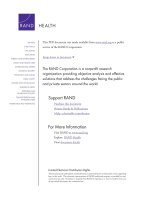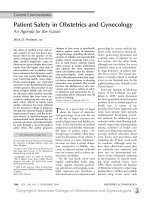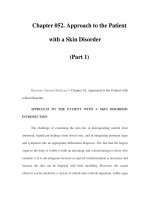1 patient safety
Bạn đang xem bản rút gọn của tài liệu. Xem và tải ngay bản đầy đủ của tài liệu tại đây (757.67 KB, 33 trang )
Introduction to
Patients Safety
Outline
• Introduction and defining patient safety
• The key dimensions of healthcare quality
• Harm Versus error
• Sources of System Error
• Patient safety culture
• Types of clinical incident
• Seven levels of safety
• The physician’s role in patient safety
• Case scenario
05/10/2023
Patient Safety
2
Objectives
•
After completing this lecture you should:
– Recognize the magnitude and the importance of patient safety
– Define and describe the key elements of healthcare quality
– Summarize the differences between error and harm
– Recognizing characteristics of a just culture
– Differentiate between the different types of clinical incidence
– Describe several specific behaviors you can practice to foster a culture of safety in
your workplace
05/10/2023
Patient Safety
3
Defining patient safety
• The reduction of risk of unnecessary harm
associated with health care to an acceptable
minimum. (WHO, World Alliance for Patient
Safety 2009).
05/10/2023
Patient Safety
4
Introduction
• Significant numbers of patients are harmed due to their health
care, either resulting in permanent injury, increased length of stay
(LOS) in health-care facilities, or even death.
• 44 – 98,000 deaths annually caused by medical error.
• There are more deaths annually as a result of health care than
from road accidents, breast cancer and AIDS combined.
05/10/2023
Patient Safety
5
Defining patient safety-Video
• />
05/10/2023
Patient Safety
6
Why is it a problem?
Hospital/Country
Years in which data was Number of hospital
collected
admissions
Number of
adverse event
Adverse event rate
(%)
US(Harvard Medical
Practice Study)
1984
30195
1133
3.8
Australian (Quality in
Australian healthcare
study )
1992
14179
2353
16.6
UK
1999-2000
1014
119
11.7
Denmark
1998
1097
176
9
KKUH
2014
47211
2950
6.2
Source: World Health Organization. Executive board 109th session, provisional agenda item3,4,5, 2001,EB 109/9
05/10/2023
Patient Safety
7
Safe
Familycentered
Effective
Key Elements of
Professionalism
Timely
Efficient
Equal
The 6 key dimensions of healthcare quality
•
Safe: Avoiding injuries to patients from the care that
is intended to help them.
•
Effective: Providing services based on scientific
knowledge to all who could benefit and refraining
from providing services to those not likely to benefit
(avoiding underuse and overuse). Doing the right
thing for the right person at the right time.
05/10/2023
Patient Safety
9
The 6 key dimensions of healthcare quality
•
Timely: Reducing waits and
sometimes unfavorable delays for both those
who receive and those who give care.
•
Family-centered: Providing care that is
respectful of and responsive to individual
patient preferences, needs and values, and
ensuring that patient values guide all clinical
decisions.
05/10/2023
Patient Safety
10
The 6 key dimensions of healthcare quality
•
Efficient: Avoiding waste, in particular waste of
equipment, supplies, ideas and energy.
•
Equal: Providing care that does not vary in
quality because of personal characteristics such
as gender, ethnicity, geographic location and
socio-economic status
05/10/2023
Patient Safety
11
Sources of System Error
All errors can be divided into two main groups:
•
Active errors or human error are
committed by frontline staff and tend to
have direct patient consequences.
•
Latent or system errors are those errors
that occur due to a set of external forces
and indirect failures involving
management, protocols/ processes,
organizational culture, transfer of
knowledge, and external factors
– Example, giving the wrong medication,
treating the wrong patient or the wrong
anatomical site, or not following the
correct policies and procedures.
05/10/2023
– Example : understaffed wards or
inadequate equipment.
Patient Safety
12
Error in medicine
• Errors in health care can be caused by ‘‘active
failures’’ or ‘‘latent conditions.’’
• Most errors are not a result of personal error or
negligence, but arise from system flaws or
organizational failures
05/10/2023
Patient Safety
13
"Swiss cheese" model of accident causation
05/10/2023
Patient Safety
14
"Swiss cheese" model of accident causation
• The systems have many holes: some from active failures and others
from latent conditions.
• These holes are continuously opening, shutting, and shifting their
location. In any one slice, they do not normally cause harm, because the
other intact slices prevent hazards from reaching the potential victim.
• Only when the holes in many layers momentarily line up does the
trajectory of accident opportunity reach the victim causing the damage
05/10/2023
Patient Safety
15
Definition of patient safety culture
An integrated pattern of individual and organizational behavior, based
on a system of shared beliefs and values, that continuously seeks to
minimize patient harm that may result from the process of care
delivery.
05/10/2023
Patient Safety
16
Defining patient safety-Video
• />
Patient safety culture
• If a patient is found to have received the wrong medication and suffered a
subsequent allergic reaction,
• Blame culture: we look for the individual student, pharmacist, nurse or
doctor who ordered, dispensed or administered the wrong drug and blame
that person for the patient’s condition care at the time of the incident and
hold them accountable
• Just Culture: we look for the system defect such as communication ,
protocols and processes for medication management , in addition to
investigate the negligence or recklessness of the worker
05/10/2023
Patient Safety
18
The concept of Clinical incident:
Definition:
•
A clinical incident is an event or
circumstance resulting from health
care which could have, or did lead to
unintended harm to a person, loss or
damage, and/or a complaint.
(deviation from standard of care and
safety )
05/10/2023
Examples:
•
•
•
•
•
•
•
•
•
•
Medication errors (e.G. Wrong medication,
omission, overdose);
Patient falls;
Intended self harm or suicidal behaviour;
Therapeutic equipment failure;
Contaminated food;
Problems with blood products;
Documentation errors;
Delayed diagnosis;
Surgical operation complications;
Hospital acquired infection;
Patient Safety
19
Types of Clinical incident
Clinical Incidence
Adverse
Event
Near Miss
Sentinel Event
Adverse Drug reaction
05/10/2023
Patient Safety
20









